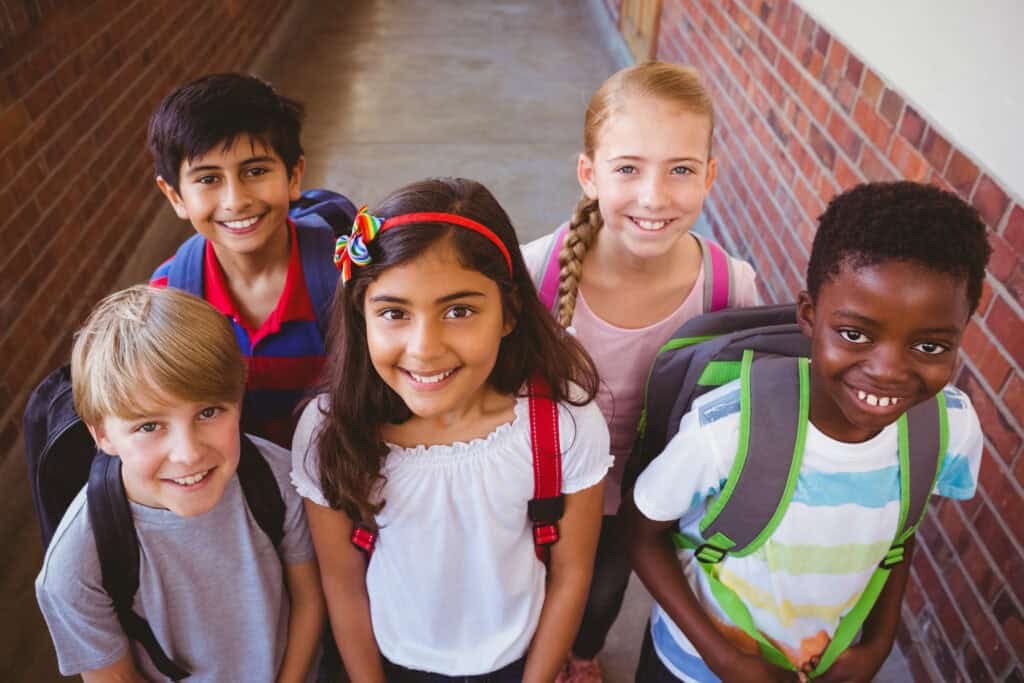
In my first blog post in January 2024 entitled “This Is The Single Most Powerful Word In Education,” I wrote about the importance of having and fostering a growth mindset (“I can learn or do anything if I put in effort and am open to guidance”). A growth mindset can be encapsulated in the ever-optimistic word “YET,” meaning “I may not be able to do something yet, but I’m going to keep working at it until I succeed!”
One of the ways to foster a growth mindset (as opposed to a fixed mindset in which improving oneself is unlikely) is to start with a positive frame of mind. As a teacher and role model for students, I thought I would share some specific things you can do that will bring a positive attitude to your classroom and to each student in attendance. As a bonus, you will gain positivity from the great feedback you will receive from your students…and you can do it all without ever saying a word!
THE POWER OF A POSITIVE ATTITUDE
 I recently read an intriguing book called The Happiness Advantage by Harvard teacher and TED talk superstar Shawn Achor. In the book he talks about a piece of his research that revealed when humans are in a positive frame of mind they are 31% – 37% smarter than when they are in a negative – OR NEUTRAL – frame of mind.
I recently read an intriguing book called The Happiness Advantage by Harvard teacher and TED talk superstar Shawn Achor. In the book he talks about a piece of his research that revealed when humans are in a positive frame of mind they are 31% – 37% smarter than when they are in a negative – OR NEUTRAL – frame of mind.
When high-stakes tests come around, wouldn’t it be wonderful for your students to be at least 31% more ready, more focused – smarter? In the lessons leading up to major benchmarks, don’t you want your students to be drinking in the information and instructions you offer? Of course you do! According to Shawn Achor, starting with a positive frame of mind can be a major (and free) first step! So how can you start making this happen immediately?
Introducing The Teacher’s N.E.S.T.™
Over the last two years, I  began applying concepts typical of non-education organizations to the specific needs and concerns I know exist within education. Some of the most important involve the elements of Emotional Intelligence. While other consultants and organizations have developed curriculum to teach “EQ” or “SEL” (social emotional learning) to students, I have applied these and other Emotional Intelligence-based ideas specifically for teachers to address, in very practical ways, each student’s emotional learning centers in advance of addressing their logical learning centers. This approach has led to what I call the Teacher’s N.E.S.T.™ (Neuro-Emotional Skills & Tools). I believe the research that suggests if you can create a positive frame of mind every day, for every class, with every student you foster a better learning climate that has potential to yield incredible learning outcomes.
began applying concepts typical of non-education organizations to the specific needs and concerns I know exist within education. Some of the most important involve the elements of Emotional Intelligence. While other consultants and organizations have developed curriculum to teach “EQ” or “SEL” (social emotional learning) to students, I have applied these and other Emotional Intelligence-based ideas specifically for teachers to address, in very practical ways, each student’s emotional learning centers in advance of addressing their logical learning centers. This approach has led to what I call the Teacher’s N.E.S.T.™ (Neuro-Emotional Skills & Tools). I believe the research that suggests if you can create a positive frame of mind every day, for every class, with every student you foster a better learning climate that has potential to yield incredible learning outcomes.
There are many elements of the Teacher’s N.E.S.T.™ model that I will be sharing in future blogs, but for today I’ll introduce the first three. Used in isolation they are powerful, but as you practice and use them together, they can be paradigm shifting and initiate effort and collaboration from your students in ways you may never have thought possible.
ADDED BENEFITS: These skills are powerful, and they will work in your professional and personal interactions as well. So if you are so bold as to practice them, you might start by using them on your significant other (just promise not to hold me responsible for any additional dependents you may have on next year’s tax return! I’m just a messenger of great research!)

Teacher’s N.E.S.T.™ #1: Frequently Show OPEN PALMS
The best way to get your students into a positive mindset and optimally ready to learn is this: Greet every single student with one or both palms (of your hand) open as if waving (if overhanded) or welcoming (if underhanded). I’m not suggesting false enthusiasm or that you need to hug every student; merely cordiality.
Why does it matter?
As far back as our prehistoric ancestors, humans took cues from the hands of str angers they encountered.Identifying danger or safety was essential to survival back then. Hands are often the first thing seen as others approach or we approach others. Open palms indicate an absence of visible weapons and are, therefore, less threatening. Psychologically, still today, open palms send non-threatening messages as opposed to a closed palm or the extremely hostile index finger-point.
angers they encountered.Identifying danger or safety was essential to survival back then. Hands are often the first thing seen as others approach or we approach others. Open palms indicate an absence of visible weapons and are, therefore, less threatening. Psychologically, still today, open palms send non-threatening messages as opposed to a closed palm or the extremely hostile index finger-point.
The best way to show intention toward anyone, especially students, is to show them you are not a threat, and you want good things for them. By showing your open palms in a greeting or inviting manner, you are telling each student that you are delighted they have come to school, you acknowledge them individually as special to you, and you imply that they will be safe in your classroom.
POWERFUL NEUROCHEMICALS
Open palms combined with a genuine smile are too intoxicating for the receiver to resist because, when we feel safe, our brains produce two extremely powerful chemicals. The first chemical is called oxytocin (the connecting molecule). Oxytocin is so powerful it is sometimes used in larger doses to induce labor! The second chemical is called dopamine (the motivating, rewarding molecule). Many phone apps and casino games rely on initiating dopamine “hits” to compel players to continue playing (remember Candy Crush? “Oh, yeah!”)
 When students are greeted with open palms, fear of harm dissipates and calms the limbic system of their brain, which assesses safety and danger. By welcoming each and every student with an open palm, even without a smile, the dynamic of the day will almost always turn positive. Furthermore, by sending out such positive signals, your own brain will release oxytocin, dopamine, and serotonin (the stress relieving molecule) for you, and you will likely feel your breathing and heartbeat slow while you begin to feel genuine gratitude and appreciation for each and every student in your care.
When students are greeted with open palms, fear of harm dissipates and calms the limbic system of their brain, which assesses safety and danger. By welcoming each and every student with an open palm, even without a smile, the dynamic of the day will almost always turn positive. Furthermore, by sending out such positive signals, your own brain will release oxytocin, dopamine, and serotonin (the stress relieving molecule) for you, and you will likely feel your breathing and heartbeat slow while you begin to feel genuine gratitude and appreciation for each and every student in your care.
Even though it is easy to get busy, make an effort to greet your students at the door of your room as they arrive each day, and ALWAYS greet each of them with an open palm gesture. Your students will give you the time you need to write the board notes, take attendance or lunch count, and even forgive a rocky beginning of the day IF they know you have seen them, you have greeted them, and you appreciate them. They will reciprocate with hard work and respect, or at least, most of them will.
TIP: You will probably have to be intentional to remember to use open palms at first, and maybe even need to set a reminder on your phone. Soon, though, you will develop a habit that becomes equally beneficial to you and your students.
Teacher’s N.E.S.T.™ #2: Display A Genuine Smile

The second element of the Teacher’s N.E.S.T.™ is to greet students with a genuine smile. Who among us doesn’t enjoy being smiled at?
At an early age a smile indicates a universal message of happiness, content, joy, satisfaction, accomplishment, and many other positive emotions. Among my favorite memories are the days when I would arrive home from work to be tackled by my twin five-year-olds wielding great big smiles without any front teeth! Smiles are great!
What is it about a smile that is so enjoyable and effective?
It turns out it is our biology! Humans are designed to use our mouths to demonstrate a plethora of emotions to others, and that demonstration has the ability to contagiously affect everyone who sees the smile to respond with a similar response. And it turns out, the smile is universal.
This discovery was proven by Dr. Paul Ekman from the University of California San Francisco. He has studied cultures all over the world, including some who have never had the influence of modern movies or television, and he confirmed that a smile (along with six other facial expressions) means the same thing in all human cultures!
 I wonder if that’s why Golden Retrievers are so popular? Anyway…
I wonder if that’s why Golden Retrievers are so popular? Anyway…
Some smiles are fake or sinister, but we can almost always detect disingenuous smiles. So what makes a genuine smile genuine and impactful? Researchers have actually done a significant amount of study in this area, and some obvious and not-so-obvious findings have emerged consistently.
CHARACTERISTICS OF A GENUINE SMILE
 The first characteristic of a genuine smile is that it activates, not just the corners of one’s mouth, but also the muscles in the cheek area that lift the cheeks and the eyes. Often this also causes “crows feet,” the three-pronged wrinkle extending outward from the corner of the eyes toward the ears. The cheek raise is more prominent in some than others, but the “crows feet” wrinkles at the eyes are a very consistent cue.
The first characteristic of a genuine smile is that it activates, not just the corners of one’s mouth, but also the muscles in the cheek area that lift the cheeks and the eyes. Often this also causes “crows feet,” the three-pronged wrinkle extending outward from the corner of the eyes toward the ears. The cheek raise is more prominent in some than others, but the “crows feet” wrinkles at the eyes are a very consistent cue.
Teachers who enjoy their jobs and their students can smile genuinely forever! Teachers who are stressed out by school pressures and personal pressures seem to really struggle to find reasons to smile. By generating gratitude for your students and greeting them well, the feelings become reciprocal and often have a lifting effect in spite of other goings-on.
Students aren’t any different. There are a lot of students who come to school every day from situations teachers don’t know or want to know. These situations are tragic, mostly because there is so little a teacher can do to intervene. But there is absolutely something EVERY teacher can do, and that is to transmit joy, happiness, and gratitude to provide even temporary relief through a smile…a genuine, full-faced smile that says, “I’m so glad to see you. You – yes, you – are important to me!” Your smile may be the only one a child sees that day, and they will not forget it.
Bottom line: If you want to be a teacher of phenomenal impact and influence, start with a simple, genuine, REAL smile intentionally sent to every student, every class period, every day.
Teacher’s N.E.S.T.™ #3: Make Pleasant Eye Contact
 The third Teacher’s N.E.S.T.™ element is an extremely powerful way to influence your students (and anyone else). It is to make intentional eye contact, not in a creepy way, of course, but in a sincere gesture of interest. Some scientists and researchers refer to this as gazing.
The third Teacher’s N.E.S.T.™ element is an extremely powerful way to influence your students (and anyone else). It is to make intentional eye contact, not in a creepy way, of course, but in a sincere gesture of interest. Some scientists and researchers refer to this as gazing.
The difference between gazing naturally and staring creepily is determined by how much is displayed in the whites of our eyes. A gaze maintains a natural amount of eye “white” in the corners with perhaps a sliver above or below the iris (the eye “color”). Staring tends to exaggerate the amount of white showing in the eyes. Too much may be perceived as over-eagerness if friendly, or more uncomfortably as one may fear a “stalker” (or a clown). Too little white is often perceived as a message of anger, disgust, or malevolence.
TRY THIS!
If you have access to a mirror, take a look at yourself under each of these scenarios. First, imagine  you are looking at a puppy. Did you notice the amount of white you displayed? Unless you are fearful of puppies from a prior childhood traumatic experience ( and I’m so sorry if you are), you probably displayed a number of “warm” emotional cues to indicate affection. If puppies aren’t your thing, try kittens or baby hedgehogs. Notice the pleasing amount of white and color. This is endearing and comforting to both the giver (you) and the receiver (whomever is looking back at you). This is an appropriate gaze that will complement your open palms and genuine smile to non-verbally tell your students, without question, that you are pleased by their attendance.
you are looking at a puppy. Did you notice the amount of white you displayed? Unless you are fearful of puppies from a prior childhood traumatic experience ( and I’m so sorry if you are), you probably displayed a number of “warm” emotional cues to indicate affection. If puppies aren’t your thing, try kittens or baby hedgehogs. Notice the pleasing amount of white and color. This is endearing and comforting to both the giver (you) and the receiver (whomever is looking back at you). This is an appropriate gaze that will complement your open palms and genuine smile to non-verbally tell your students, without question, that you are pleased by their attendance.
MORE MIRROR FUN!
Now let’s experiment with too much or too little eye “white.” First, imagine you are looking in the mirror and, instantly, a snake appears! Or a huge spider with a furry back and hairy legs – whatever creeps you out. What is your reaction?
 If you are like most people, you are negatively surprised, so your eyes widen to scan for other threats. This is an automatic, emotional-brain response. When surprised you will naturally open your eyes wider for self-preservation until your logical brain has time to assess the situation and determine an optimal course of action. Of course, this only takes the brain a fraction of a second in real time, so showing the maximum white for a split second doesn’t seem creepy. BUT, if you hold that eye position while looking at a student, it gets creepy FAST!
If you are like most people, you are negatively surprised, so your eyes widen to scan for other threats. This is an automatic, emotional-brain response. When surprised you will naturally open your eyes wider for self-preservation until your logical brain has time to assess the situation and determine an optimal course of action. Of course, this only takes the brain a fraction of a second in real time, so showing the maximum white for a split second doesn’t seem creepy. BUT, if you hold that eye position while looking at a student, it gets creepy FAST!
The opposite of  “over-whiting” the eyes is to show too little white. As a former Assistant Principal of a junior high school, these eye positions were quite prevalent, especially among females competing over another student’s affection. Oh, the stares and glares that darted around the cafeteria were like laser beams! Occasionally guys would do this,too, but it often made them look as if they were trying to solve a difficult math problem in their head. I’m not sure why.
“over-whiting” the eyes is to show too little white. As a former Assistant Principal of a junior high school, these eye positions were quite prevalent, especially among females competing over another student’s affection. Oh, the stares and glares that darted around the cafeteria were like laser beams! Occasionally guys would do this,too, but it often made them look as if they were trying to solve a difficult math problem in their head. I’m not sure why.
The other time you might see this eye-white level in a non-threatening way is on the cover of any “Most Beautiful People” magazine. Almost without fail the hottest male will be looking back into the camera as if taking an eye exam or reading very small print. This intentionally provocative look may also be called a “shmize” according to relational expert Vanessa Van Edwards, founder of The Science of People.
 After trying these looks in the mirror – I realize some of you spent way too long on this exercise! – imagine a typical reaction if you used each of these as the students entered your room. Can you imagine the students’ reactions if you used “Big Eyes” continuously as they entered your room? Within fifteen minutes you would be “trending” on every social media site under #psychoteacher !
After trying these looks in the mirror – I realize some of you spent way too long on this exercise! – imagine a typical reaction if you used each of these as the students entered your room. Can you imagine the students’ reactions if you used “Big Eyes” continuously as they entered your room? Within fifteen minutes you would be “trending” on every social media site under #psychoteacher !
What if you used the closed eye stare with every student? How many would ask you if you were mad at them or ask you “what’s wrong”?
CONNECTING
 But what if you greeted every student with an inviting gaze, even the student who is tardy or disruptive? Such a pleasantry would not be an endorsement of the child’s non-compliant behavior; instead it would be an endorsement of their value as a person, and some of them might not know just how valuable they are!
But what if you greeted every student with an inviting gaze, even the student who is tardy or disruptive? Such a pleasantry would not be an endorsement of the child’s non-compliant behavior; instead it would be an endorsement of their value as a person, and some of them might not know just how valuable they are!
If you were to use a sincere gaze combined with a genuine smile and an extended open palm gesture, wouldn’t you make every student feel like an invited, welcomed guest to your classroom? Isn’t that how you like to be greeted by your best friends or your spouse?
For those students with whom you were actually able to lock eyes, the brain would produce a small but significant amount of oxytocin, the “connecting” molecule, which would further encourage trust and camaraderie between both of you (similar to open palms, remember?). The student would have a more positive mindset as they prepare to learn, and after so much positive feedback from greeting dozens of students, even you – the teacher – would greatly benefit from the oxytocin, dopamine, and serotonin activated in your own brain.
Of course, three silent non-verbal cues aren’t likely to eliminate every emotional or learning obstacle you will face each day. But it will give you and your students a great chance to begin strong! Besides, you never know what could happen next.
PUT IT INTO PRACTICE
Try greeting each and every student with an open palm, a genuine smile, and a pleasant eye gaze at the start of each class. You might be amazed at the effort you begin to receive. The desire to please those who validate us is almost instinctive, and you as the teacher will be primed to deliver your best lesson and your best self to your classes. Without a single word or a wasted minute of time you will have created a Happiness Advantage in both you and your students!
NECESSARY NOTE: To be fair to Shawn Achor, his research and findings go much deeper and have many more applications that are tremendous for education and educators. I can’t wait to share them with you in future posts and videos.
Finally, I appreciate all you do for your students. I hope this post has been helpful. I also hope you will continue to check back for more great tips and ideas. My goals are to help every one of you achieve the impact you desire, and to restore and enhance your joy as a professional educator persevering under extraordinarily difficult conditions. You are building a lasting legacy!
For the Greatest Good,
Dr. Tom
